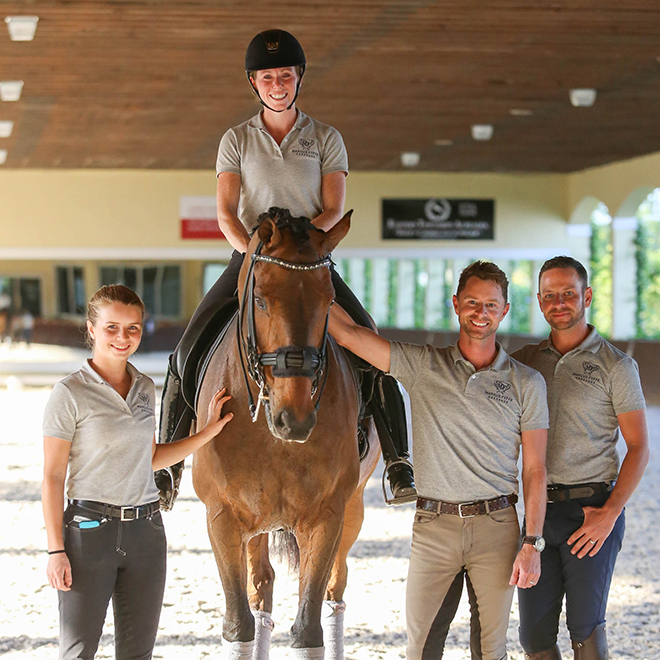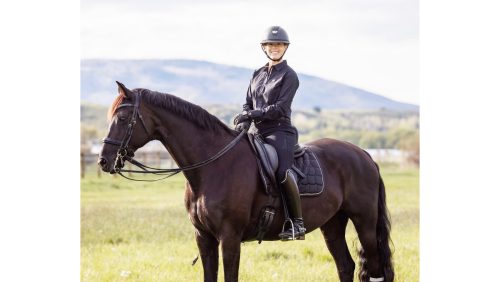Canada’s David Marcus and Australia’s Nicholas Fyffe focused on the learning process as they worked with a range of dressage horses and riders during an April 13 clinic at their year-round base, Stillpoint Farm in Wellington, Fla. The two international Grand Prix competitors married in November 2015 and jointly operate Marcus Fyffe Dressage.
Effective learning involves making mistakes, which many ambitious, driven riders may not enjoy. But both trainers urged their students to see slip-ups as opportunities to make corrections and ultimately improve.
“Mistakes are an important part of training,” Marcus said. “That is where the learning takes place.”
At one point, Fyffe reminded Laura Killian to keep a feeling of elasticity in her reins on Zaomi, a 12-year-old Dutch Warmblood mare, rather than constantly trying to hold the horse in the correct frame.
“If she is leaning on the reins, let her make that mistake and fall out of the right frame, then bring her back—don’t hold her there,” he said. “Set her up where she could make a mistake, and then react really well to the mistake. I don’t want you to micromanage her.”
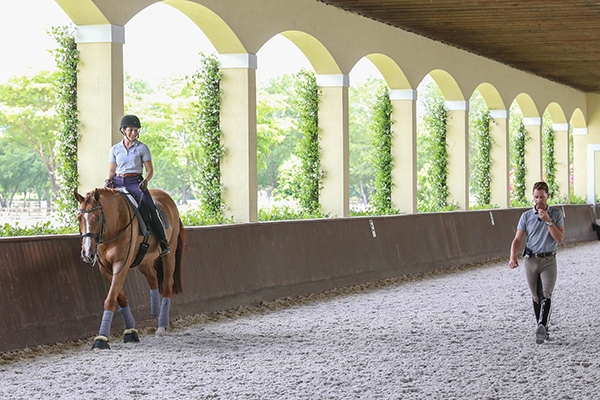
Nicholas Fyffe talked to Micah Deligdish on Zilano about the importance of ending the ride on a good note. Photo by Mary Adelaide Brakenridge.
Fyffe explained that when a horse takes responsibility for carrying himself, he is able to sustain the correct balance and rhythm even when the rider relaxes the aids.
“What happens if you give the reins? Nothing. What happens if you take your legs away? Nothing. I love it,” Fyffe said to Micah Deligdish as she worked on the canter with her horse Zilano. “He’s maintaining what you’ve created.”
Setting Up the Horse For Success
While showing the value of making mistakes, Fyffe and Marcus also emphasized giving horses confidence by putting them in situations where they could succeed. They noted that riders must present their mounts with appropriate questions and prepare thoroughly for exercises to give their horses every chance at executing them well.
ADVERTISEMENT
“We don’t learn if we don’t push ourselves out of our comfort zone, but we don’t want to push to the point where the horse can’t do what we’re asking him,” Marcus said.
Fyffe focused on proper preparation while schooling young rider Katrina Sadis, who was gearing up for a show the next day. He had her “check” the pirouette by preparing for it without actually riding it, reducing the need to drill the movement. During their session, he asked her to focus on the quality of the gaits, making sure she loved the trot or canter before asking for a movement.
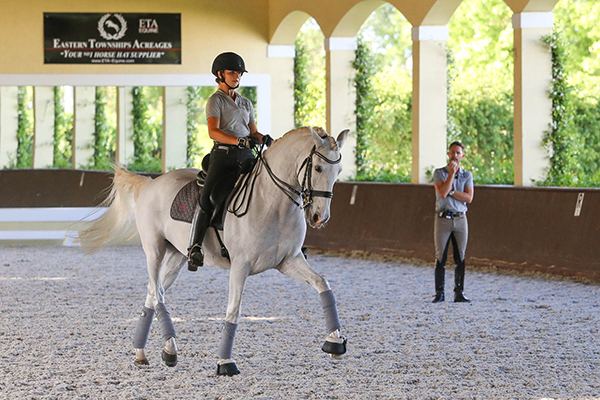
Nicholas Fyffe worked with young rider Katrina Sadis, riding her longtime partner Zepelim. Photo by Annan Hepner.
Coaching Marcus on Binjora, his up-and-coming Grand Prix horse, Fyffe noted how Marcus takes advantage of every opportunity to set up his horse for what’s next.
“David never misses a corner,” Fyffe pointed out. “Every corner is used to reorganize the horse and bring him to a place where he’s ready for the next movement, ready for any movement.”
Marcus explained that at each gait, the rider should have the horse so on the aids that any transition is possible.
“I want to feel the ability to do anything from there,” Marcus said while demonstrating the collected walk on Tuny Page’s 7-year-old mare, Edy Rava. “You should almost not see where the transition is going to happen. If I wanted to halt, I can just close my fingers. If I wanted to ride a canter transition or an extended trot transition, it’s available to me.”
The Right Answer
Throughout the clinic, Marcus and Fyffe highlighted their systematic approach that helps the horse clearly understand when he has done something right or wrong. The trainers guided students in pinpointing when to escalate an aid and how to test a horse’s responsiveness.
“You can get an ideal reaction only if you give an ideal aid,” Fyffe said. “If you give an ideal aid and nothing happens, then you can move to a sharper aid, but always return to the ideal aid.”
ADVERTISEMENT
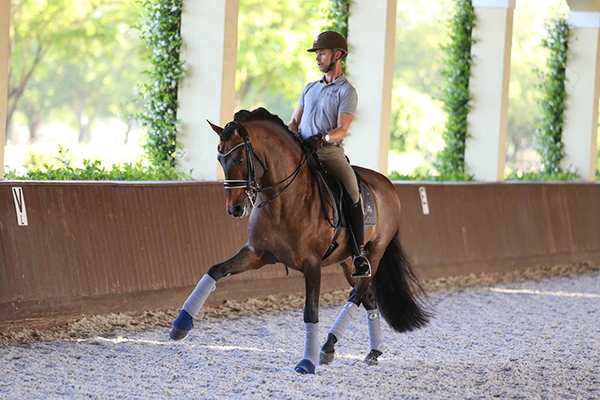
Nicholas Fyffe demonstrated the different components of a daily training ride on his up-and-coming Grand Prix mount, Fiero HGF. Photo by Annan Hepner.
Rewarding a horse’s positive reaction is just as essential as making appropriate and timely corrections.
“When he doesn’t respond to you, you have the right to follow through, and then you have the responsibility to reward him,” Marcus said. “When he gives you the right answer, I want him to know it’s the right answer.”
Marcus called on riders to praise good efforts offered by their horses, even if they fell short of the end goal.
“It is really important to reward anything that is on its way to perfection, as you want to encourage them to keep wanting to work for you,” he said. “Don’t just reward your horse when something is perfect, but whenever something is better than the previous time you asked.”
Advocating For The Horse
As Fyffe explained to the audience, trainers have the responsibility to advocate for the horse’s best interests. It is up to the trainer to determine when to end the session on a high note that sets the tone for the next day’s ride.
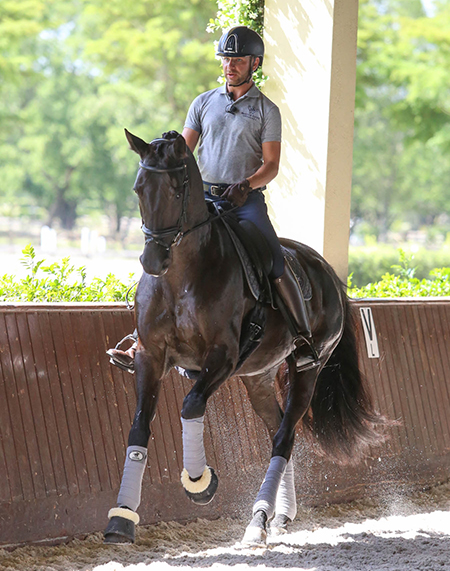
David Marcus gave Tuny Page’s Edy Rava an educational, confidence-building ride. Photo by Mary Adelaide Brakenridge.
Marcus discussed how to create a positive training experience even when the horse is nervous or distracted. Riding the young mare Edy Rava, who was a little on edge in front of the spectators, he steered clear of exercises outside of her comfort zone and instead asked her questions that would not overface her.
“I want to give her relaxing experiences while making sure she knows she has to keep working and doesn’t get the day off because she’s nervous,” he said. “It’s similar to the concept of competing at a lower level than you’re training: you shouldn’t expect the horse to be more than what they’re capable of in an environment that already makes them nervous. I want to ensure everything I teach her is from a harmonious, relaxed place.”

